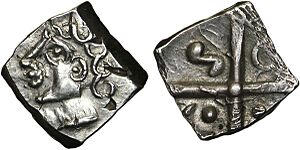Sotiates facts for kids
The Sotiates were an ancient tribe. They lived in the region of modern-day Sos, France, during the Iron Age and the Roman period. They were a mix of Gallic and Aquitani people.
In 56 BC, the Sotiates were conquered by the Roman army. This army was led by P. Licinius Crassus, who was a general under Caesar.
Contents
What's in a Name?
The Sotiates are mentioned by famous ancient writers. Caesar wrote about them in the mid-1st century BC, calling them Sotiates. Later, Pliny called them Sottiates in the 1st century AD.
The exact meaning of their name, Sotiates, is not fully clear. The ending -ates is a common part of many Gallic tribe names across Europe. It means 'belonging to'. For example, tribes like the Atrebates and Nantuates have this ending. However, the first part of the name, Soti-, is still a mystery.
The modern town of Sos is named after this ancient tribe. In the 1st century BC, it was known as oppidum Sotiatum, which means 'fortified town of the Sotiates'.
Where They Lived
The Sotiates lived in a specific area of ancient Gaul. They were located north of the Elusates and Tarusates tribes. To their south were the Oscidates. The Lactorates lived to their east, and the Cocosates to their west.
Their main town before the Romans arrived was called Sotiatum. Today, this is the town of Sos. It was built where the Gueyze and Gélise rivers meet.
Their History
We know about the Sotiates from two important ancient books. One is Caesar's Gallic Wars. The other is Cassius Dio's History of Rome.
The Gallic Wars (58–50 BC)
In 56 BC, the Sotiates faced the Roman army. Their leader was a chief named Adiatuanos. He led his people in defending their main town against the Roman officer P. Licinius Crassus.
The Sotiates first attacked the Roman army with their cavalry. When their horsemen were defeated, they revealed their hidden foot soldiers. These soldiers were waiting in a valley. They attacked the scattered Roman cavalry, and the fight began again.
The battle was long and tough. The Sotiates fought bravely, believing they were protecting all of Aquitania. The Romans wanted to show what they could do without their main general, Caesar. After many losses, the Sotiates finally fled. Many of them were killed.
Crassus then marched directly to the Sotiates' town and began to attack it. The Sotiates defended their town strongly. They even tried to dig tunnels under the Roman siege equipment. The people of Aquitania were very skilled at mining.
However, the Roman soldiers were too strong. The Sotiates realized they could not win. They sent messengers to Crassus and asked to surrender. Crassus agreed, and they started to hand over their weapons.
While this was happening, Chief Adiatuanos made a final attempt. He led 600 of his loyal followers, called soldurii, from another part of the town. These soldurii were very devoted to their leader. They would share everything with him in life and even die with him if he faced danger.
Adiatuanos and his soldurii tried to break out of the town. But the Romans quickly reacted. There was a short, fierce fight. Adiatuanos was forced back into the town. Even after this, he still asked Crassus for the same surrender terms, and Crassus granted them.
Their Culture
Historians still discuss whether the Sotiates were more Gallic or Aquitanian. Their way of life was very similar to that of the Gauls. This has led some experts to think they might have been a Gallic people who moved to the edge of Aquitania.
In the mid-1st century BC, the Sotiates, led by Chief Adiatuanos, fought the Romans alone. Other Aquitanian tribes had formed a group to fight the invaders, but the Sotiates did not join them. The name Adiatuanos might come from a Gallic word meaning 'eagerness' or 'ambition'.
Caesar mentioned that Chief Adiatuanos had 600 special guards called soldurii. Some scholars believe this word comes from the Gallic language, meaning 'bodyguard' or 'loyal'. Others think it might come from the Aquitanian language, possibly related to the Basque word for 'debt'.
No matter the origin, the soldurii were very loyal to Adiatuanos. Their relationship was like a patron and client, similar to how some Gallic groups worked. The fact that Adiatuanos had 600 of these men shows he had a lot of personal power over different family groups.
It's also possible that the Sotiates were an Aquitanian tribe that had adopted many Celtic (Gallic) customs before Caesar arrived. A sword found near their town, dating back to the 3rd century BC, shows that valuable Celtic items were used by the local people. This suggests that the Aquitaine region was greatly influenced by Gallic culture, especially further north and east from the Pyrenees mountains.
See also
 In Spanish: Sociates para niños
In Spanish: Sociates para niños


